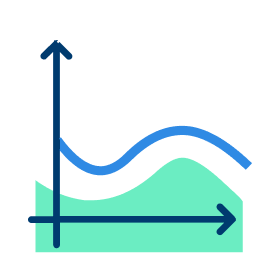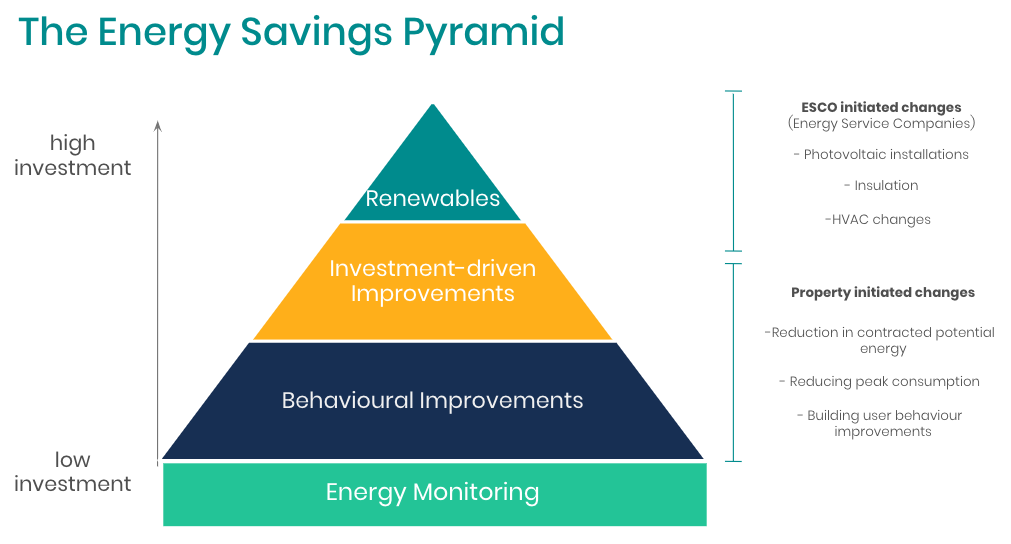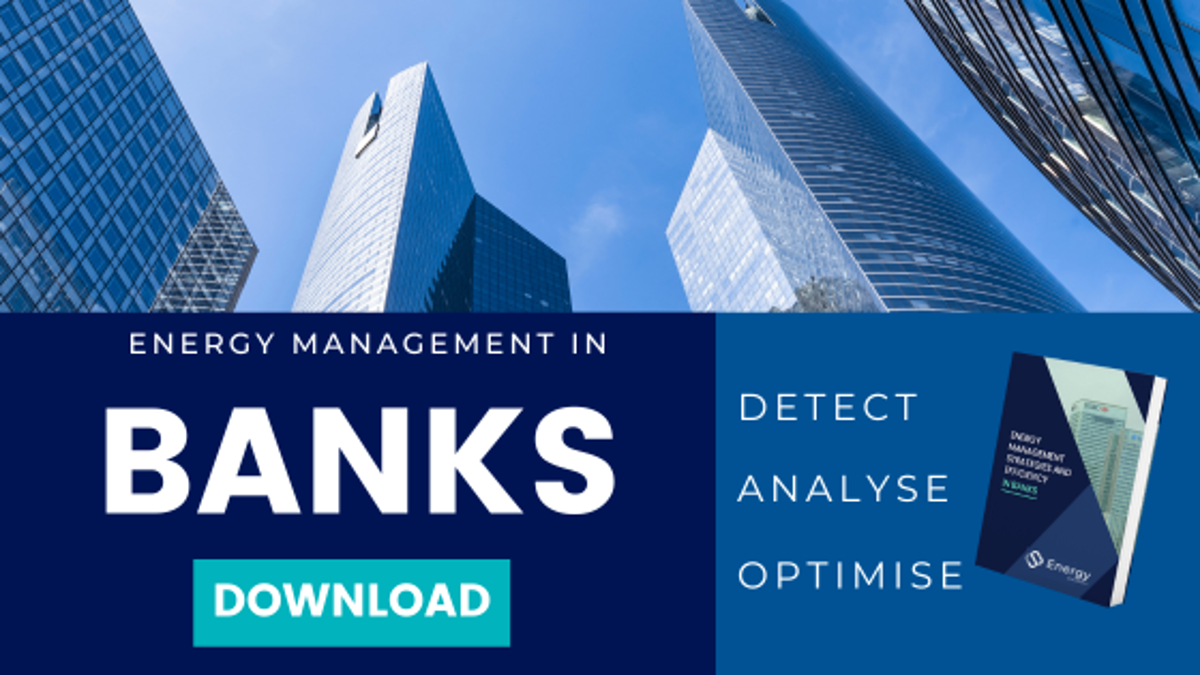Making your bank’s branches and headquarters consume energy in a smart way is the goal of any bank today. In this article you will discover the phases that a bank must carry out to implement a smart energy plan, highlighting the smart energy control phase.
Making your bank’s branches and headquarters consume energy in a smart way is the goal of any bank today. But, what are the steps that we must follow to arrive at the “Smart Energy Management Branch” concept?
How to implement an Advanced Energy Analysis by Phases in Banking
The key to the success of a smart energy management plan in banking is being able to roll it out in phases. Specifically, three phases:

Phase 1: Detect saving potential in Branches and Offices WITHOUT audits or investing in Hardware
In this first phase, you should start by making a general analysis of how you are consuming energy. But not in order to know how much you’re spending, you already know that. Or to know where there is a shortcoming (you probably also know it or sense it). You have to analyse to quickly detect where the greatest energy-saving potential is.
Why? Simply and plainly: if you first invest in the locations with the greatest saving potential, you will recover the investment earlier, and you can continue to apply it to branches with less potential.
And so on, until your entire network of corporate offices and branches is 100% efficient. How is this analysis performed? Energy audits were necessary until now.
Energy audits are good, but they have two disadvantages:
- They are expensive. About €15 per square meter. If we think of the hundreds or thousands of your bank’s branches, it is a significant cost.
- They take a lot of time. It can take between six months and one year to have your audits completed.
Why not take advantage of technologies that are already available to detect your saving potential more quickly and at a cost that is ten times lower?
There are already tools that don’t require any investment in hardware or on-site audits. These tools work thanks to the use of Big Data and Artificial Intelligence (AI), which, through their algorithms, are able to identify the energy-saving potential simply with your bills.
One example of these advanced saving potential detection tools is the Spacewell Energy (Dexma) Detect platform. The Spacewell Energy (Dexma) Detect not only helps you to know where and how much you can save in your offices, but it also helps you to segment in order to prioritise your investments. And to add a bonus to the service, this tool helps you to save from the first minute thanks to the periodic recommendations you will receive to reduce your bills.
The Energy Savings Pyramid
Smart energy management projects require smart work. If you start by knowing where you can save more and faster, it will help you follow the energy-saving pyramid model: start from – investment to + investment, from simpler improvements to more advanced improvements.
You should consider that the higher up in the pyramid the actions you want to start, the more investment you will need. But, at the same time, those with the highest ROI tend to recover the most quickly.
According to a report (in Spanish) prepared by Endesa in 2017, the corrective measures WITHOUT investment represent an average saving of 15%, while the corrective measures WITH investment account for up to 40%.
There are measures that have a return on investment in months or even an immediate one. Examples of return in 0 years that we have seen in banking projects include, among others, the following measures:
- Optimisation of contracted power.
- Fine-tuning of temperature set-points.
How do you get such a fast and spectacular ROI? If the base of the pyramid is built in an adequate manner (good measurement) and has the necessary and specific data analysis tools for the banking sector.
| Pro-Tips |
|
Phase 2: Analyse the energy consumption of your bank branch offices to control it

In this phase, an investment in measuring equipment and some advanced energy management solution is necessary.
What will you achieve with this perfect combination of hardware+software?
- Perform real-time analysis of multiple energy parameters, that is, monitor and analyse the energy sources used in offices (electricity, renewable energy, water).
- Analyse the comfort of users, both employees and customers. Here we would need a tool that will help the energy manager of the offices to measure and analyse data such as temperature, CO2, lighting, etc. Optimising these consumptions will not only result in energy savings, it will improve comfort.
- Analyse the behaviour and performance of the equipment and facilities in each type of office. This will allow you to detect existing inefficiencies and plan corrective actions. Doing this is important as it will influence the investment amount: perhaps you should change some equipment that is in poor condition or look for more efficient ones, for example.
- Configure alarms and consumption reports. These will automatically warn you of consumption spikes.
- Predict future consumption (forecasting) and be able to better plan the purchase of energy for the next month.
- Take measures and verify the savings obtained (MVP). With this type of tool, you can create monitoring reports to check if the energy-saving targets set are being met and start the control phase of the project, where unnecessary passive consumption occurs, and optimise and adjust your facilities to continue saving.
Once you have all this information, it’s time to start work on executing an energy efficiency project. It is evident that you won’t save simply by analysing, so use that information to plan and execute.
Now is the time to carry out active energy management in the offices, from correcting passive consumption and peak consumption to training staff in order to encourage more efficient and sustainable energy consumption.
But, of course, without forgetting that monitoring and analysing will also help you control. Spacewell Energy (Dexma) Platform will support your control and automation system (BAS; BMS or SCADA). Maybe you thought that having an EMS was like having a BAS, but they are not the same. Maybe this infographic will help you to understand it better.
Phase 3: Control Analytics (FDD) in Banking

If you have not implemented good energy analysis software: How can you apply good remote management and control measures? Would you know when the offices are wasting energy in the air conditioning system? Or which floors in the head office can save more if you install motion sensors in the lighting?
Also, if you only have one control system… how will you know something is wrong? Something we often see in banks without management or energy analytics is that it takes months to detect problems.
Imagine that you have an automation system that turns off lights and air conditioning just when you leave and sets the alarm when the branch office door is closed. Maybe the system doesn’t turn off the lights or the air conditioning of one of the areas and they are switched on for the rest of the night. How do you know if, on opening again, everything is automatically turned on as it should be?
With the Spacewell Energy (Dexma) Platform, it would be as simple as opening your email: you would have a high consumption alert during non-operational working hours. It will also be received by those responsible for maintenance so that they can look at this control element as soon as possible.
This technology is known as “control analytics”. It is also referred to by its acronym: FDD (Fault Detection and Diagnosis).
With Spacewell Energy (Dexma) Platform, you can automate the process of detecting failures in physical systems, and digital processes and diagnose their potential causes. Spacewell Energy (Dexma) Platform collects data on air conditioning and lighting systems, among others, as well as meter data to determine faults.
How does it do it? Thanks to artificial intelligence and big data technologies, the standards and limits that the system must comply with are defined. Spacewell Energy (Dexma) Platform Platform activates alerts based on these standards and creates consumption and cost forecasts thanks to machine learning.
And, in addition to those alerts, as the person responsible for your bank’s energy consumption, you can take advantage of this control analytics system to create:
- Updated reports on the project and savings, and share them with finance, branch managers, communication, etc.
- Measurement and verification projects based on the IPMVP protocol. With them, you can show that you have saved up to the last cent of what the data says.
At this point, you’ll be at the end of phase 3, but you may find this information insufficient, so … why don’t you download the complete Smart Energy Management Guide for Banks? In it, you will find not only the 3 phases you have known here, but also extra energy control tips for banks, where bank offices consume more energy, what to look for in a controller for bank branches, and much more. Now you can download it in PDF for free: ⬇️






